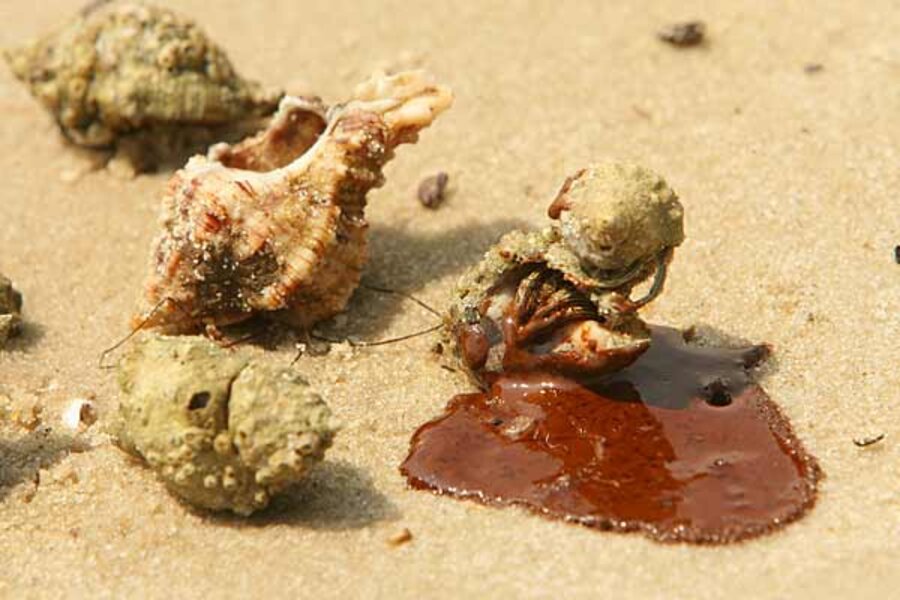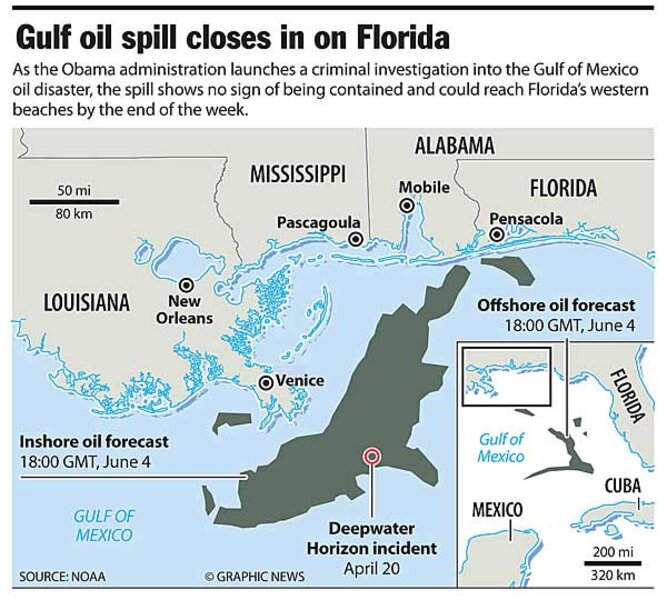BP oil spill spreads toward Pensacola, as wildlife toll rises
Loading...
| Atlanta
The focus of the BP oil spill relief effort is shifting eastward – toward the beaches of Alabama and Pensacola, Fla. – as the slick's toll on Gulf wildlife slowly mounts.
Tar balls bobbed toward Pensacola, threatening to make Florida the fourth Gulf state directly affected by the undersea geyser from BP's Deepwater Horizon well off the Louisiana coast.
As a result, federal and state governments are moving booms and skimmers eastward.
IN PICTURES: The Gulf oil spill's impact on nature
"There's a lot of tactical movement of boom right now as the threat is shifting to Mississippi and Alabama," says Coast Guard Adm. Thad Allen.
Meanwhile, the National Wildlife Federation reported Wednesday that six to nine times more sea turtles are turning up dead than usual. Similarly, the 29 stranded dolphins found since the spill began represent two to six times the normal amount. So far, 444 birds and 222 sea turtles have been found dead in the area, according to a recent tally provided by the US Fish and Wildlife Service.
It's not yet clear whether a higher than average dolphin mortality rate can be blamed on the spill, although "no oil" has so far been found inside the dead dolphins, says Jane Lubchenco, administrator of the National Oceanic and Atmospheric Administration (NOAA).
Species ranging from sperm whales to Kemp's Ridley sea turtles, from pelicans to already depleted bluefin tuna, could all be impacted by the spill, scientists say. The degree to which dispersants being used have made the situation better or worse for sea life is one key question NOAA scientists will try to answer in an unprecedented federal study of the worst oil spill in US history.
In Louisiana, 120 miles of shoreline has been inundated by oil from the spill.
The oil slick spread toward the northeast on Tuesday. Adm. Allen reported that tarballs and "sheen" had washed ashore on Dauphin Island, Alabama, and on Petit Bois Island, off Pascagoula, Miss. Florida Gov. Charlie Crist said he expects tar balls to hit Florida "in a day or two."
As federal skimming boats move eastward, Alabama, Mississippi, and Florida are deploying booms to protect their valuable white sand beaches. Florida officials say they are laying 66,000 feet of boom off the state's three westernmost counties.
A federal decision on whether to give the go-ahead to a proposed protective berm project across some Louisiana barrier islands is expected later Wednesday.
The Coast Guard continued to close federal fishing waters as the spill spread. More than one-third of available fishing grounds are now off-limits for fishermen.
Taking to sea from New Orleans today, the NOAA vessel S 222 Thomas Jefferson will join several other US science ships that are now beginning to measure in detail the extent of the spill, the depth of reported plumes of oil, and whether a kerosene dispersant is helping or hurting the relief effort.
The research vessels will help determine the true flow rate of the runaway Macondo well. Estimates so far have gone steadily up, now at 12,000 to 19,000 barrels a day. BP first estimated that the well was spewing 1,000 barrels, eventually revising that to 5,000 barrels a day.
The size of the spill is important not only to figure out the best response, but it is also integral to BP's potential civil and criminal liability for the spill. Critics say BP has been downplaying figures to reduce its potential liability in what promises to be a lengthy court process once, and if, the well can finally be capped.
"The administration understands the environmental and legal and financial reasons to get good measurements of the flow rate," Ms Lubchenco said, during a conference call from Houma, La.
Related:






